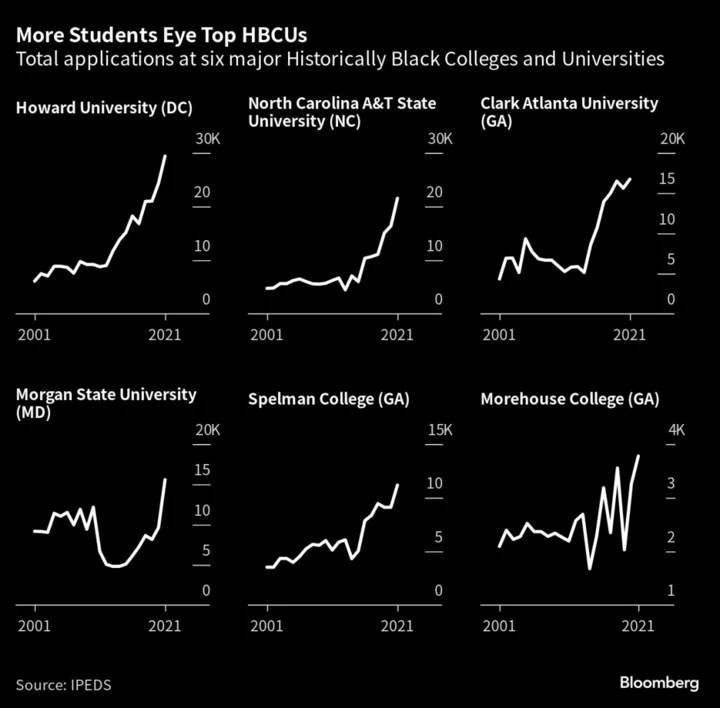Historically Black Colleges and Universities are gearing up for an increase in applicants following a US Supreme Court decision barring schools from using race as a factor in admissions.
While the ruling says schools can consider an applicant’s individual life experience – which may pertain to race – the change could lead to fewer Black students at the country’s most-selective universities as hundreds of schools revamp their admissions policies.
“There is a likelihood of a shift in underrepresented students looking to go where they feel welcome,” said Emily Wadhwani, a senior director at Fitch Ratings Inc.
But any influx of applicants at historically Black institutions could be problematic for a cohort that is already underfunded and short on resources. Even before the court’s decision, HBCUs, which were founded to educate Black people but are now open to all races, started to see heightened interest resulting from George Floyd’s murder by Minneapolis police in May 2020 and the Black Lives Matter movement.
“For many HBCUs like Spelman, applications have been increasing,” said Helene Gayle, president of the historically Black women’s college in Atlanta. “So we expect that trend will probably accelerate as a result of this decision.”
The total number of applicants at 35 HBCUs more than doubled in the last 20 years, rising to nearly 233,500 in 2021, according to National Center for Education Statistics data.
As schools receive more applications, some have expanded their student bodies. With more than 9,000 students, Morgan State University saw record enrollment in fall 2022. The Baltimore, Maryland, school is expecting that demand to continue. For this fall, Morgan State received about 25,000 applications.
Similarly, Morehouse College in Atlanta, which has about 2,200 students enrolled, is anticipating a 50% to 100% increase in applicants over the next three years.
“In the current frame of resources that we have available to us, we could not absorb that kind of increase and continue to provide the quality of education that Morehouse guarantees its applicants unless we had a significant infusion of resources from a combination of philanthropist, corporations and the government,” Morehouse President David Thomas said.
Morgan State President David Wilson advocates for more federal funding to be allocated to HBCUs as those institutions become “the models of diversity in American higher education.”
Read more: Black Colleges Gain as Enrollment Dips Elsewhere: Muni-Wise
‘Call to Action’
The record $2.7 billion of federal funds that the American Rescue Plan Act injected into HBCUs during the pandemic was a rare investment. Less than 1% of federal research and development grants are awarded to HBCUs, the Brookings Institution recently wrote.
South Carolina State University, which saw nearly 15,000 in applications for the upcoming school year, has asked the state for about $200 million to help with campus improvements. So far this year it has received nearly $55 million.
The Supreme Court decision “is a call to action to invest in HBCUs,” said Howard University’s Executive Vice President and Chief Operating Officer Tashni-Ann Dubroy.
Although HBCUs represent a small portion of higher education institutions, they produce 70% of all Black doctors and dentists, 50% of Black engineers and 35% of Black lawyers, according to United Negro College Fund.
While the recent calls for racial justice and equality has spurred philanthropic organizations and the nation’s wealthiest to invest in historically Black institutions in the past couple of years, donations have started to drop off.
Read more: Blackstone’s Gray Gives $3 Million to Fund Scholarships at HBCUs
“We have not received another eight-figure gift since MacKenzie Scott’s $20 million,” said Thomas in an email. “I am optimistic the decision will lead donors to make greater investment in Morehouse College and other HBCUs. That said, the jury is still out.”
According to a recent Brookings report, the 10 largest HBCU endowments were 100 times smaller than the 10 largest endowments for predominantly White institutions.
“Howard would need 10, 15, 20 times the investment we currently have not only for us to have a stable institution over time but also to invest in additional facilities,” said Dubroy. Howard has an endowment of $900 million as of 2022, compared to Harvard University’s $50 billion, she added.
Spelman College’s endowment is at about a half a billion.
“If I compare that to some of our peer women’s liberal arts colleges, their endowments are three, four, even six times as large as ours,” said Gayle, adding that with the anticipated increase in enrollment “doubling our endowment over time would be just the bare minimum to be able to keep pace with the need.”
--With assistance from Andrew Harrer and Andre Tartar.

